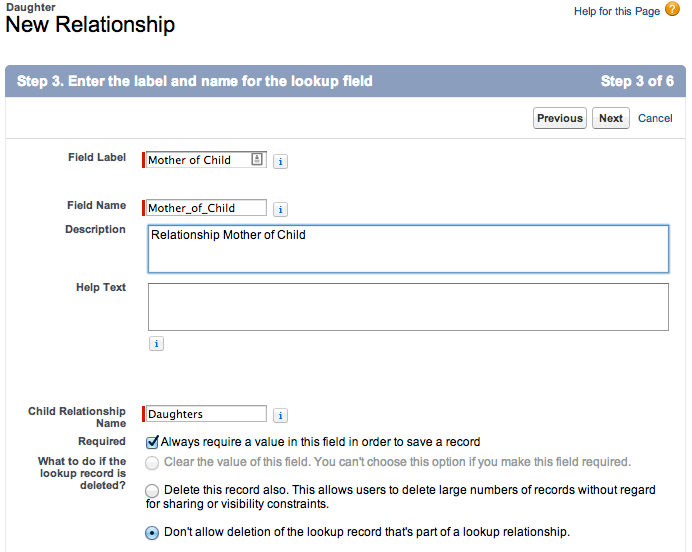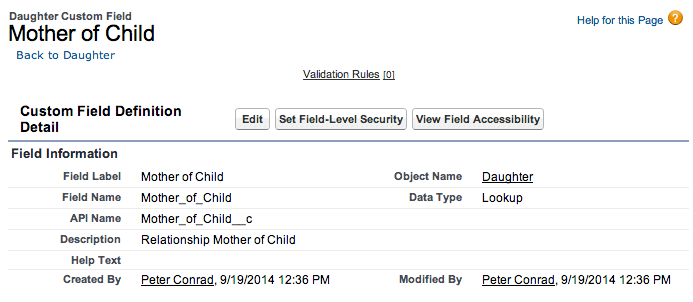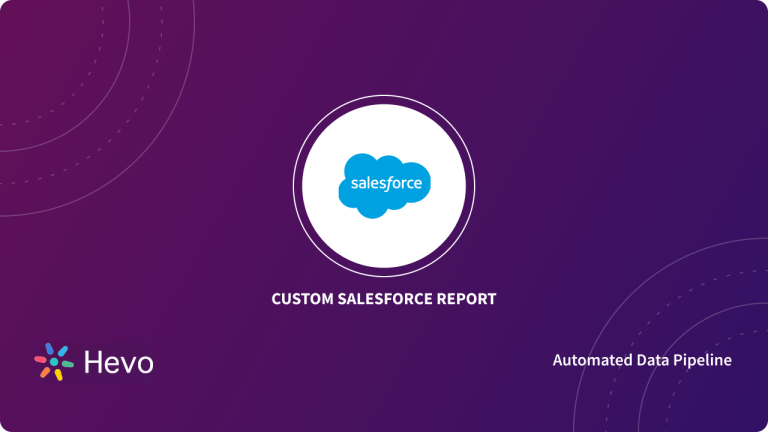 Key Takeaways
Key TakeawaysSOQL join objects empower you connect related Salesforce records. Whether through parent-to-child, child-to-parent, custom object, inner, semi, or anti joins. Each join type unlocks a smarter way to query complex relationships and retrieve exactly the data you need.
Keep in mind that Salesforce enforces limits on how many relationships and hierarchy levels you can traverse, so optimizing your joins is key.
And if your goal is to move Salesforce data into a data warehouse for deeper analysis, Hevo’s no-code pipeline makes it effortless. Ensuring fast, reliable, and automated data flow without manual intervention.
Enterprises across the globe have seen a significant surge in their businesses by using the SaaS platform of Salesforce. While the CRM solution plays a significant part to ensure seamless information flow and visualization across the length and breadth of the client organization, value addition significantly relies upon the use of various data modules to extract meaningful and actionable insights. Salesforce Object Query Programming language (SOQL) is one of the key tools to query the data, to convert it into the required information.
Upon a complete walkthrough of this article, you will have a decent understanding of Salesforce along with the Salesforce Object Query Language. You will also be able to leverage SOQL Join Objects to establish joins and relationships between various objects. Read along to learn more about SOQL Joins.
Table of Contents
Prerequisites
- Basic understanding of SQL.
Introduction to Salesforce Object Query Language(SOQL)
Salesforce is a US-based tech firm founded in 1999 that offers innovative solutions to business enterprises in the realm of customer relationship management (CRM). It primarily follows the SaaS (Software as a Service) model in the business-to-business (B2B) domain while laying its foundations on a Cloud-Based architecture. Ranging from Marketing, Analytics, Learning, Integration, Sales, and Services to employees and stakeholder management, Salesforce provides customized modules for its client enterprises to enable value addition for the latter.
Salesforce Object Query Language (SOQL) is an Application Programming Interface (API) used to search partner organization’s Salesforce data. It is primarily used when enterprises have built a custom User Interface (UI) for Salesforce while using different modules (data is recorded and then arranged by Salesforce). While SOQL is case insensitive, it is very easy to use to write queries for fetching the data when required. It can retrieve data from a single object or multiple objects that are related to one another. Not only can it traverse the data from number, date, or checkbox fields but also sort results as part of the query. Read about using SOQL to query the Salesforce database.
Migrating your data can become seamless with Hevo’s no-code intuitive platform. With Hevo, you can:
- Automate Data Extraction: Effortlessly pull data from 150+ connectors like Salesforce(and other 60+ free sources).
- Transform Data effortlessly: Use Hevo’s drag-and-drop feature to transform data with just a few clicks.
- Seamless Data Loading: Quickly load your transformed data into your desired destinations, such as BigQuery.
Try Hevo and join a growing community that relies on Hevo for seamless and efficient migrations.
Get Started with Hevo for FreeUnderstanding Objects
In SOQL, database tables with the provision of storing data relevant to a particular business enterprise in any given module are called Objects. Generally, there are two types of objects:
- Standard Objects: Objects that are already built into Salesforce, e.g., accounts, contacts, cases, users, products, campaigns, etc.
- Custom Objects: Objects created by the client enterprise for effective reporting, visibility, and insights. These objects form the basis of Data Sharing, Custom Fields, Relationships to other objects, Page Layouts, and Customized UI Tab.
Use Cases of SOQL
Whether to use SOQL or not depends upon various considerations, the most important of which are the requirements of the users in the enterprise. Generally, SOQL is used when it is known that data is placed in specific objects. Other considerations may include:
- Extract data from either a single object or multiple objects which are associated with each other.
- Given a criterion, tally the count of records that meet its conditions and sub-conditions.
- Sort the output information as a constituent element of the query.
- Retrieve the data by traversing the date, number, or checkbox fields.
Understanding SOQL Join Objects
SOQL Join Objects and gives enterprises the flexibility to establish multiple relationships via joining different objects. It not only enables enhanced visibility but can generate actionable insights for the higher management to steer the organization’s strategy in the right direction. SOQL Join Objects becomes particularly useful in SOQL as it reduces data redundancy and data inconsistency for the relevant databases. They can be:
- One to one
- One to many
- Many to one
- Many to many
SOQL join objects using different queries depending upon the client organizations’ data structures and information requirements. To understand the joining frameworks, it’s of utmost importance to understand the relationship players which exist in the SOQL universe, given as follows:
Parent Object and Child Object
Depending upon the requirements, objects in Salesforce can be categorized as Parent and Child. The object that has a greater number of data fields can be labeled as a Parent, and the one with fewer fields can be labeled as a Child. Essentially, the Parent object contains the data, while the child object has the lookup field against which data is required. Every relationship in SOQL is given a name; e.g., an account can be considered a parent of contact.

The name of the relationship could vary, depending upon the direction of the queried data. Given the Child-to-Parent relationships, the title of relationship to the Parent is the name of the foreign key. Similarly, for Parent-to-Child relationships, Child relation is given the title which is exclusive to the connected Parent, and also is the plural of the Child object name. Learn how to work with delete queries in SOQL to delete records from your data.
Parent to Child Query
Sometimes, it is required to query the data by “One to Many” relationship; it is generally categorized as a Parent to Child query. Users would want to visualize or at least structure all the contacts associated with the specific accounts. “Inner Query” is used to traverse the data modules for the said joining and the general syntax is given as follows:
To extract the Contacts associated with a particular Account, the following SOQL Query can be used –
SELECT Id, Name, (Select Id, Name FROM Contacts) FROM Account WHERE Id IN:accListChild to Parent Query
Sometimes, it is required to query the data by “Many to One” relationship; it is generally categorized as a Child to Parent query. The general syntax for the said joining is given as follows:
While working with the Contacts records, one can look up through all the data and retrieve any field e.g., Account Shipping Address from a particular contact, with the SOQL query mentioned below:
SELECT Id, Name, AccountId, Account.ShippingAddress FROM ContactCustom Objects Relationship
In Salesforce, users can certainly establish relationships amongst custom objects using SOQL Join Objects – it also ensures that not only custom object names, but also the names of custom fields and the associated relationships remain unique to avoid any confusion and redundancy in traversing the databases. Whenever a new custom object is created in the UI of SQL, it demands the user to specify the plural variant of the object name, which is used in the joining queries.

Once a join is created, it is worth noticing that the associated API name is the name of the created custom field, appended by __c. Similarly, when custom objects are formed in the SOQL data visualization, the relevant API name (object name appended by __c), and same should be used to prevent any ambiguity, especially when SaaS can create a standard object with the same name as of custom object/field.

An example of the syntax for joining two custom objects is given as follows:
<complexType name="Daughter__c">
<complexContent>
<extension base="ens:sObject">
<sequence>
...
<element name="Mother_of_Child__c" nillable="true" minOccurs="0"
type="tns:ID"/>
<element name="Mother_of_Child__r" nillable="true" minOccurs="0"
type="xsd:string"/>
<element name="LastName__c" nillable="true" minOccurs="0"
type="ens:Mother__c"/>
...
</sequence>
</extension>
</complexContent>
</complexType>
<complexType name="Mother__c">
<complexContent>
<extension base="ens:sObject">
<sequence>
...
<element name="Daughters__r" nillable="true" minOccurs="0"
type="tns:QueryResult"/>
<element name="FirstName__c" nillable="true" minOccurs="0"
type="xsd:string"/>
<element name="LastName__c" nillable="true" minOccurs="0"
type="xsd:string"/>
...
</sequence>
</extension>
</complexContent>
</complexType>Outer and Inner Joins
A Random join in SOQL isn’t supported but it surely provides some features to control related objects in the relevant modules of Salesforce. One of them is Inner Join: it is primarily used to join the objects (Parent and Child) to extract all the associated fields from the base objects which may include the data of non-referred related objects. For example:
SELECT NAME, ACCOUNT__r.NAME FROM PROJ__C.- This is a SOQL (Salesforce Object Query Language) query that retrieves data from the custom object
PROJ__C. - It selects the
NAMEfield from thePROJ__Crecords. - It also retrieves the
NAMEfield from the relatedACCOUNT__robject, which represents a relationship to an account. - The
ACCOUNT__rprefix indicates that the query is accessing a related object’s field, using a relationship reference. - The results will display the names of the projects along with the names of the associated accounts for each project.
Here, the name and account name are retrieved from the object project, which is essentially labeled as a custom project. Here, the Parent object is the Account, and the child object is a project, while the relationship between the two is the Look-up relationship. The custom objects, as usual, are characterized by the __r keyword in SOQL.
Inners joins in SOQL are utilized for the filtering of records that aren’t matched with the required informative objects i.e., unmatched records can be eliminated via filtering conditions. For example:
SELECT NAME, ACCOUNT__r.NAME FROM PROJ__C WHERE ACCOUNT_c !=NULL.- This is a SOQL (Salesforce Object Query Language) query used to retrieve data from the custom object
PROJ__C. - It selects the
NAMEfield from thePROJ__Crecords. - It also selects the
NAMEfield from the relatedACCOUNT__robject, indicating a relationship with accounts. - The
WHERE ACCOUNT_c != NULLclause filters the results to include only those records where theACCOUNT_cfield has a value (i.e., it is not null). - The query returns project names and their associated account names only for projects that are linked to an account.
Semi Joins and Anti Joins
Semi-Join and Anti-Join queries can be used to enhance the usage and effectiveness of relationship queries in SOQL Join Objects. They are particularly useful when dealing with parent-to-child and child-to-parent relationships. While utilizing the sub-query mechanisms, they allow the records to be filtered from one database to another. Before delving into the details of the subject joins, it’s critical to realize that one can extract values related to an object in any field, even though other fields contain the records for the same subject: it is done using IN function.
SELECT Name FROM Account
WHERE BillingState IN ('California', 'New York')More so, the level of complexity can be increased by employing the sub-query modules with IN and NOT IN. It can mesh by ID (primary key) or reference (foreign key) fields. A subquery applied on another object in an IN condition to confine the records extracted is called the Semi-Join. On the other hand, an Anti-Join is a subquery on another object in a NOT IN condition to confine the records extracted. The usage of these sub-query joins might include, but isn’t limited to:
- Get all contacts for accounts that have an opportunity with a particular record type.
- Get all open opportunities for accounts that have active contracts.
- Get all open cases for contacts that are the decision-maker on an opportunity.
- Get all accounts that don’t have any open opportunities.
For example, a Semi-Join can be used in a WHERE clause and as mentioned below, can extract the account IDs if the relevant opportunity is forgone in the parent to child semi-join from Account to Opportunity.
SELECT Id, Name
FROM Account
WHERE Id IN
( SELECT AccountId
FROM Opportunity
WHERE StageName = 'Closed Lost'
)Similarly, the following Anti-Join query can return account IDs, given the condition that accounts are those which don’t have any open opportunities:
SELECT Id
FROM Account
WHERE Id NOT IN
(
SELECT AccountId
FROM Opportunity
WHERE IsClosed = false
)Limitations of SOQL Join Objects
Like every other Query Language, SOQL Join Objects is guided by a specific set of limitations which are discussed as follows:
- The existence of a relationship between two objects is the prerequisite of using joins in SOQL.
- A query can cater up to fifty-five (55) Child-to-Parent relations. The relationship counts for a custom object are limited to forty (40). For the Parent-to-Child query, the number of viable relationships stands at twenty (20).
- In any given Child-to-Parent relationship, only five (5) levels can be traversed for data query.
- Only one (1) level can be specified for the data query in any given Parent-to-Child relationship.
- Additional data i.e., notes and attachments can be queried for the relevant information but filter can’t be applied to the content on these resources.
- For external objects, any give sub-query can extract and display up to a thousand rows.
- For external objects, any given query can have up to four (4) joins. While the execution of the query is in progress, every join requires a complete traverse of the external system, which results in longer response times.
Conclusion
In this article, you learned about Salesforce, its key features, and how to leverage SOQL Join Objects to establish relationships between multiple objects. Integrating and analyzing your data from a diverse set of data sources can be challenging and this is where Hevo Data comes into the picture.
Hevo is a No-code Data Pipeline and has awesome 150+ pre-built integrations that you can choose from. Hevo can help you integrate your data from numerous sources, such as Salesforce and load it into a destination to analyze real-time data and create your Dashboards. It will make your life easier and make data migration hassle-free. It is user-friendly, reliable, and secure.
Want to take Hevo for a spin? Sign Up for a 14-day free trial and experience the feature-rich Hevo suite firsthand. You can also have a look at the unbeatable pricing that will help you choose the right plan for your business needs.
Share your experience of learning about SOQL Join Objects. Let us know in the comments below!
FAQ on SOQL Join Objects
1. Can you join objects in SOQL?
In Salesforce Object Query Language (SOQL), you cannot directly join objects in the same way you would in SQL with a JOIN clause. Instead, you use relationships and subqueries to retrieve related records.
2. How do I join two objects in Salesforce?
You can join two objects in Salesforce using Lookup and Master-Detail fields between objects, then write a SOQL query with nested SELECT statements to retrieve fields.
3. What is a join object?
In Salesforce, a “join object” typically refers to a custom object that serves as an intermediary between two related objects, facilitating many-to-many relationships.
4. Is join possible in Elasticsearch?
Yes, Elasticsearch supports joining data from multiple indices or documents using the concept of nested and parent-child relationships.
5. What are the limitations of SOQL Join Objects?
a. Maximum 55 Child-to-Parent and 20 Parent-to-Child relationships per query.
b. Only 5 levels deep for Child-to-Parent joins.
c. Queries on external objects can include up to 4 joins and fetch 1,000 rows per subquery.
6. How can I handle complex joins between custom objects in SOQL?
Use relationship fields and the __r notation for joins between custom objects. Ensure unique field and relationship names to prevent ambiguity in queries.
7. How can I test and optimize SOQL join queries?
You can use Salesforce Developer Console or Workbench to write, test, and analyze your SOQL queries. Optimize by selecting only required fields and limiting nested queries.
8. Is SOQL case-sensitive?
SOQL is not case-sensitive, but object and field names must match Salesforce API names exactly, including underscores and suffixes like __c.





